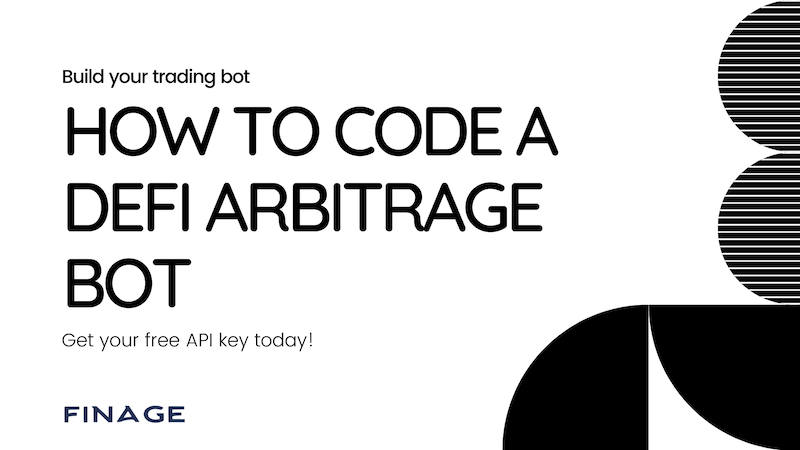Back to Blog
by Finage at August 11, 2021 4 MIN READ
Technical Guides

How to Code a DeFi Arbitrage Bot
Decentralized platforms are gaining popularity at an alarming rate. At this pace, it is safe to say that the future of trading could be decentralized. As more investors pay attention to such platforms, the demand for effective trading tools has increased as well. One such tool is using a Defi Defi bot. In this article, let’s look at how to code this tool and incorporate it into your trading strategies.
Before we can go into the details about coding an arbitrage bot, there are some concepts that we need to look at briefly.
What Is Arbitrage?
Arbitrage is the purchasing and reselling of any asset in order to make a profit from it. The profit, in this case, is generated due to the difference in the assets’ value between different markets. This practice is not a recent one, in fact, it has been used since the late 18th century by sea merchants.
How does this practice fit on a decentralized blockchain? To understand this, let's look at an example. You can buy any coin e.g. ETH in one blockchain and immediately exchange it for another coin on a different platform. The assets you now own can be sold for a profit when traded on a different chain. This strategy works exceptionally well when you are able to discern the spread between your initial trading pairs. This is one of the biggest obstacles traders using arbitrage Defi bots face.
Understanding Why Arbitrage Is Paired with Defi
Arbitrage has already made an impact on centralized trading. It has actually been used for centuries. Decentralized markets have recently provided the opportunity for arbitrage to be used and many traders have since then embraced it. How does having an arbitrage strategy improve your trading? The best feature of using arbitrage bots is that they only serve to ensure that you are getting more opportunities to turn in a profit on your investments.
These bots are designed to work without a prediction algorithm, which is an important feature in most decentralized trading tools. Arbitrage bots work in the present and all the opportunities you get are identified in real-time.
The advantage of using an arbitrage bot is that the possibility of losing money on a trade is almost zero, even if your strategy does not go according to plan. If you happen to run into this situation, all the transactions you carried out will be reversed thanks to the work of flash loans.
This operation is not a feature of arbitrage on centralized markets, where running into a loss is a reality.
What Is Involved in Coding the Bot?
Now that we know what arbitrage is and why it works well with a Defi bot, let's proceed to look at how you can code the bot to fit in your trading strategy. The following steps will explain how to to do this:
Structure
You will work with two folders during this step. The first is titled index and is basically a node that is designed to get the up-to-date crypto prices. The second one is a trading bot that alerts you when a good arbitrage opportunity is found. This program will make use of a flash loan and automatically do the trade on your behalf.
Setup
Traders can only trade successfully with an arbitrage bot after they create a personal smart contract. The purpose of this contract is to take care of all the details involved with flash loans and the entire process of decentralized trading as a whole.
Environment set up
Here you have to take care of the previous code by cloning it. To do this you have to access a file titled “example”. When accessed you will proceed to enter information into the blank spaces in different fields already provided. These include:
- Address and private key
- Gas limit
- Estimated gas
Handling the Constructor and Flashloan
The constructor tool is designed to help you convert the Ethereum you have to wrap Ethereum or wETH. Which will serve as the means for making payments in your trading strategies. To properly incorporate the arbitrage feature in your Defi bot make sure it has the ability to interact with the flash loan. Without this, you will not be able to identify lucrative arbitrages.
Customization
After working on all the coding, you have to make sure you make the necessary tweak to ensure that you have a unique tool. By Personalizing your bot, you reduce the competition brought by other users of the default bot. Here are a few changes you can make:
- You can add different trading pairs for your arbitrage
- Boost the performance of your bot by making sure it handles all edge cases
- Include several exchanges
- Incorporates different trading plans into your bot
Summing up, once you have finished coding your bot, you can let it run and test it. You can leave it for some time and make a review later on its performance. If you are not satisfied, you can make more tweaks until you are happy with the final product. If you are not very confident about your coding skills, you can always have a professional do it for you to minimize any chances of error.
You can start building your own Defi arbitrage bot with Finage free API key.
Build with us today!
Featured Posts

Impact of AI on Forex Trading: Analyzing Advancements & Integration
April 19, 2024

Why Crypto & Blockchain Are So Important in 2024?
April 18, 2024

Emerging Markets and Their Influence on Global Stock Indices
April 17, 2024

Web3 Security Challenges and Solutions
April 16, 2024

Quantum Computing and Its Potential Impact
April 15, 2024
Categories
Forex
Finage Updates
Stocks
Real-Time Data
Finage News
Crypto
ETFs
Indices
Technical Guides
Financial Statements
Excel Plugin
Web3
Tags
Your arbitrage Boost the performance
arbitrage bots
defi arbitrage bot
arbitrage strategy
defi arbitrage bot api
arbitrage api
Join Us
You can test all data feeds today!
Start Free Trial

If you need more information about data feeds, feel free to ask our team.
Request Consultation
Back to Blog
Please note that all data provided under Finage and on this website, including the prices displayed on the ticker and charts pages, are not necessarily real-time or accurate. They are strictly intended for informational purposes and should not be relied upon for investing or trading decisions. Redistribution of the information displayed on or provided by Finage is strictly prohibited. Please be aware that the data types offered are not sourced directly or indirectly from any exchanges, but rather from over-the-counter, peer-to-peer, and market makers. Therefore, the prices may not be accurate and could differ from the actual market prices. We want to emphasize that we are not liable for any trading or investing losses that you may incur. By using the data, charts, or any related information, you accept all responsibility for any risks involved. Finage will not accept any liability for losses or damages arising from the use of our data or related services. By accessing our website or using our services, all users/visitors are deemed to have accepted these conditions.